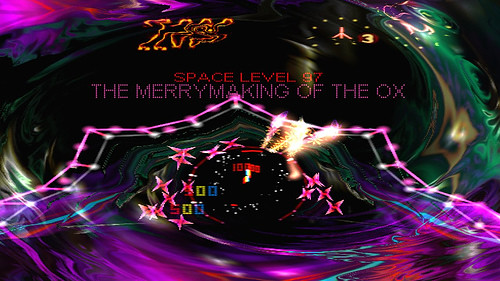Space Giraffe! (and the new if somewhat late editor…)
By: Xander
On: August 28th, 2007
Space Giraffe is the new XBLA title from Jeff Minter’s Llamasoft. Jeff Minter for those who might not know is the legendary (infamous?) mind behind the instantly recognisable and always awesome ‘Tempest 2000’. I always preferred ‘Llamatron’ more myself, but mostly because I was pretty young at the time and I couldn’t think of any better reason to blow the crap out of anything than to save beasties. Recently (read: 6 days ago) Space Giraffe hit XBLA at the very modest price of 400 MS Points, which I think is around $5/ï¿¡3.40 (for those who dislike mentally detaching themselves from the reality of what they’re actually spending). Critically, it’s been met with a pretty mixed response, with an 8/10 from the highly regarded ‘Edge’ Magazine and a 2/10 from the US OXM.
Review scores that far apart don’t only happen in Game Tunnel Monthly Round-ups, aparently. Luckily here at TIGSource we don’t rely on ratings systems or averages, mostly because it’s been a while since we studied maths, we’re a little rusty and we sold our textbooks with the answers filled in long ago to save up for impending lawsuits. So, I wont bore the crap out of you with that kind of thing (ignoring the fact that I did just that 15 seconds ago), and instead I’ll just tell you what it’s like and whether it’s something you should try to check out yourself.
And yes, yes it is…
The gameplay is really very different to Tempest, where whilst the essence is similar, the execution is refined. The main innovation is the Power Zone, which is basically an area of the playing field which constantly decreases unless you increase its size by attacking the enemies. By extending the Power Zone you increase your own powers – for instance, enemy bullets travel slower, you have additional firepower which can be directed unlike the main cannon and you earn the previously mentioned ability to ram into the enemies into the abyss for bonus points and multipliers, or just to get revenge on the sneaky ‘><’ shapes that have dragged you away time and time again taking your highscore with it.
Space Giraffe is… sort of like Tempest. Saying that has probably doomed me to be eaten by Jeff’s trained attack sheep (Fluffy: will devour writers for daily petting, grass… and great justice!) but it’s easy to mix the two up. The basis of the game is Tempest after all: your movement is restricted to the line of a strange shape as you blast away oncoming enemies. You can jump to avoid enemy attacks. You have a Super Zapper you can use once a level as a screen clearing attack. But it’s not that it doesn’t share similarities with Tempest, it’s that Space Giraffe is Space Giraffe. Your Super Zapper doesn’t scream ‘Eat Electric Death!’ You can only jump a finite amount of times using pick-ups called ‘Jump Pods’, and while you can shoot the enemies coming towards them, the only way I know of to increase your multiplier exponentially is to ram the enemies off the face of the level. Seriously. The first level is a GIANT outline of J Allard’s face (google for many a meme). Where Tempest left you in the dark recesses of space, Space Giraffe shoves you battling into a Windows Media Player Visualizer inhabited by the specters of Microsoft Executives. In a good way…
Speaking of which, compared to the relatively simple scoring system of Geometry Wars and T2K, Space Giraffe really does leave you to try and work a whole lot out for yourself. There are many different techniques beyond rushing the enemy to boost your score, and the best ways to find them are through experimentation. It encourages this kind of play with the very forgiving inclusion of being able to restart the highest level you reached, as well as being able to earn back the score you did have by successfully finishing the level. It’s by no means a way to cheat the leaderboards, because once you’ve reached the final level you can’t improve on the score anymore without playing through previous levels and improving on your last attempts, and I think that’s a relatively bold and rewarding choice. It still lets gamers go after the highest scores they can get, but it eliminates some of the grind of having to go through earlier levels you’ve mastered twenty times over, you can simply skip the easier ones that you’re proud of and pour your time into boosting scores on higher levels.
Well sorry for how long this turned out to be, feel free to kick my ass about that in the comments below! Feedback would be very handy, seeing as this is my first post and all. Later posts will be much smaller for the most part, but if anyone has any thoughts on this kind of post for XBLA style (parting with your hard-ended money/ill-gotten booty) releases, please do post away. Anyways, in the end what my argument all boils down to today is this: this is not Tempest, it’s Space Giraffe. And it’s all the better for it!
-
http://www.merseyremakes.co.uk/gibber Oddbob
-
Derek
-
Butzo
-
http://www.merseyremakes.co.uk/gibber Oddbob
-
Butzo
-
Dominic White
-
http://gnomeslair.blogspot.com/ gnome
-
http://www.blogger.com/profile/13070412747712995130 Radnom
-
Cas
-
Dominic White
-
http://www.merseyremakes.co.uk/gibber Oddbob
-
Melly
-
Tanner
-
Mizumon
-
Jason Rohrer
-
Anthony Flack


